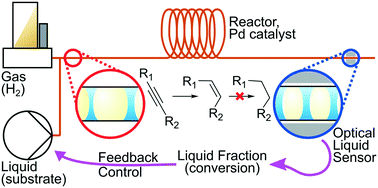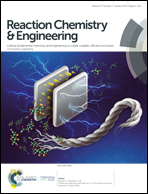Counting bubbles: precision process control of gas–liquid reactions in flow with an optical inline sensor†
Abstract
Quality by Design encouraged by the US Food and Drug Administration (FDA) in continuous flow synthesis requires tight monitoring of all the reaction input and output parameters to improve reproducibility and eliminate the process rejects. Reaction monitoring, however, relies on costly (over 10 000$) process analytical technology (PAT) – one of the factors that prevents the wider utilisation of continuous processes. In this work, we show that gas–liquid reactions can be monitored using low-cost (10$) hardware – an optical liquid inline sensor – that allows instantaneous analysis of the gas fraction in a moving stream. We discuss the application of the sensor for various gas–liquid reactions. Gas-consuming reactions such as hydrogenation are the easiest to implement because a sensor without calibration provides accurate readings close to complete consumption of the gas. Gas-evolving reactions can be monitored but require sensor calibration to determine the gas fraction accurately. Operation of the sensor was demonstrated for various hydrogenation reactions self-optimised using a proportional–integral (PID) algorithm which adjusted the substrate concentration to provide high (but not full) pre-defined hydrogen consumption. The optimised hydrogen consumption agreed with the product analysis for a range of substrates hydrogenated under various pressures and with different selectivities. The optical sensor was also proven to be an efficient tool in adapting the reaction conditions to catalyst deactivation in the reaction of 2-methyl-3-butyn-2-ol semi-hydrogenation – the autonomous reactor allowed a turn-over number (TON) of 2.7 × 106 to be reached with a value of 1.5 × 107 expected till a twofold decrease in the catalyst activity. The TON values demonstrated are significantly higher than those observed in batch reactors (∼103) even in the case of catalyst re-use (105) demonstrating a substantial improvement of process sustainability operating with the process control.



 Please wait while we load your content...
Please wait while we load your content...